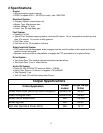
19
If the rod is made shorter it will increase the forward speed capability for that side of the mower and if the rod
is made longer it will slow down that side of the mower. So, if the mower is tracking to the left, either the left
side needs to go faster (by shortening the left-side rod) or the right side needs to go slower (by lengthening
the right-side rod). If the mower is tracking to the right, either the right side needs to go faster (by shortening
the right-side rod) or the left side needs to go slower (by lengthening the left-side rod). It is important that
neither rod should be shortened too far, as mentioned above.
The only reference point to limit the adjustment from becoming extremely off is the relative position of the
pump stop and the handlebar in the faster Speed/Sensitivity setting. Therefore, if everything is way off either
because you are installing new parts (or other reasons) you should only use the faster Speed/ Sensitivity
setting to get the tracking accurate and then change to the slower speed range and adjust the tracking only
one or two turns on either side.
After getting the mower to track straight, check and/or readjust the neutral adjustment on the pump by using
a ¼” allen wrench at the Return-to-Neutral (RTN) mechanism, if necessary. It is normal to make these
adjustments from time to time.
4.10 How to Test/Use the Blade Clutch/Brake Switch
Before testing the blade clutch/brake operation, make sure the area is clear and there is nothing vulnerable
to thrown objects from under the mower. No one should be near the mower deck or in its line of discharge.
The discharge chute deflector should be in the down position. Move the engine throttle to ¾ speed setting.
When mowing, the engine speed should always be at its highest setting. The engine governor will regulate
the engine according to the different mowing conditions at that setting. Place both feet firmly on the foot
platform and turn on the blade clutch switch. Run blades for a minute or so. Try engaging and disengaging
the blades a few times about 10 seconds apart. If the blades do not start and stop in 6-9 seconds each time,
service the blade brake system or contact your local Wright dealer. Under mowing load, the clutch’s life will
be the greatest if engaged and disengaged at the ¾ throttle level.
4.11 How to Test the Operator Presence Control (OPC) Switch
A three second time delay was added to eliminate clutch cycling on bumpy terrain.
To test, apply the parking brake and turn ON the blades, try lifting your feet off the
foot platform to test the Operator Presence Control switch (OPC). The engine
should kill and the blades should stop within 6-9 seconds. If not, service the OPC
system or contact your local Wright dealer.
WARNING


















